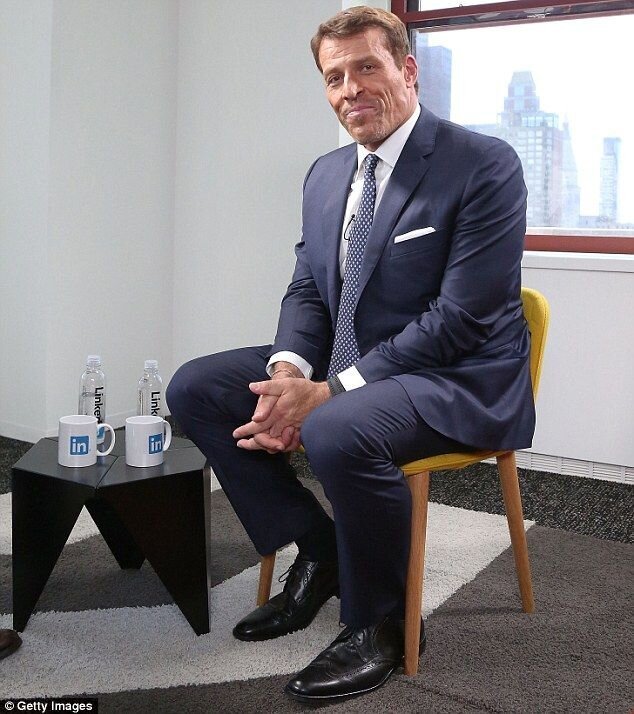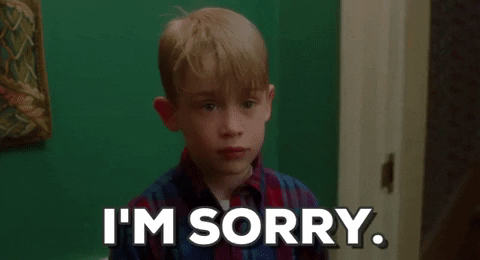The Things that Matter and the Things that Don’t
I instinctively didn’t like Tony Robbins.
I had no reason to have an opinion on Tony Robbins, but I’d seen clips of him holding people in his massive hands with his massive jaw sticking out strolling barefoot across red hot coals and it all just seemed like a lot.
That’s a regular sized chair and table. That table is 4ft tall.
But an interview I heard with Tony changed my mind. He was the exact opposite of what I’d expected - he was thoughtful, measured, sensical. One specific point he made stuck with me. He was talking about investing, and he mentioned that basically all his success in the markets came down to a simple observation: most people freak out and act irrationally at every bear market. He couldn’t understand this. He said it was the equivalent of freaking out every year when winter came.
“Will it ever get warm again? Where did this snow come from!?”
His point was that bear markets are as predictable as winter, and that neither should sneak up on anyone. Sure, you don’t know exactly when a bear market will happen, but there’s one or two every decade. There’s a really big one roughly every 10 years. And yet, every time we get close to year 10, people - experts - give reasons as to why this time will be different. And when the bear market inevitably comes, a huge chunk of people panic and Tony Robbins profits because this exact scenario has happened repeatedly through history and he knows how to act. He then invests his profits conservatively until the next bear market allows him to be aggressive again.
Humans want to be special. We want this time to be different. When we read Harry Potter no one envisions themselves as that one boring Weasley twin. We’re all Harry. So it’s hard to accept that life is mostly the same stuff happening over and over again with a slightly different backdrop and that the people who realize this do pretty well.
This translates directly to startups. We’ve worked closely with over 250 companies the past five years at Tacklebox and I’ve realized two things:
Entrepreneurship is a soft skill. Being successful has very little to do with how smart you are. During those bear market panics mentioned above, plenty of very smart people panic. Entrepreneurship is about how you behave.
Entrepreneurs need to recognize and nail the predictable stuff. The startup versions of winter surprise 95% of startup founders. Predictable things, things that have happened to every startup the past 50 years, are ignored because “this time is different.” Sometimes it’s far better to not be stupid than to be brilliant. And in this case, it’s a Tony Robbins’ Hands sized opportunity.
So let’s get into a two totally predictable things founders consistently screw up - the startup winters.
Editors Note - I wish I thought of this post a few years back and could put in a Game of Thrones gif here and say something like “for most entrepreneurs… winter is coming.”
But I didn’t. I missed the window. And I can’t think of a Queens Gambit joke.
Wildly Predictable Mistake #1: Brand
Every founder I meet wants a strong brand from day 1. They often conflate brand with design, and think their customers won’t engage with something that doesn’t look right.
They aren’t necessarily wrong, but they’re missing the point.
We talk Jobs to be Done a lot during Tacklebox, and whenever anyone says they want a strong brand I ask them - “what are you hiring that strong brand to do?”
The answer is usually something like “to make us look credible.” Which isn’t a bad thing, who doesn’t love credibility, but that’s sort of table stakes. You’re looking for trust. And not passive trust - active trust. Trust that is energizing. Trust that grabs the attention of the people you’ve chosen and gets them to do something.
You’re hiring “a strong brand” to get people who had never heard of you 30 seconds ago to decide that they want to give you their time, email address, or money.
You’re hiring a “strong brand” to acquire customers - to give your startup a chance at survival.
Fortunately, there’s a time-tested way to do this. Unfortunately, founders usually ignore it.
The Specificity ↔ Brand Equity See-Saw
When you’re an early stage startup, the vast majority of interactions you have will be first interactions. You don’t have a brand, so you’ve got to make an impression. These are zero sum interactions - you’ve got to snatch someone’s attention away from whatever else they were doing. If you can’t do this, you won’t grow.
How do you do it?
With the see-saw.
Since you don’t have brand equity, you don’t have any built up trust. You can’t be vague, no matter how bad your inner Steve Jobs might want you to.
That sentence is garbage. It says nothing. It’ll blend into the scenery. You’re only able to operate on that side of the see-saw if you have an established brand. Everlane can run this ad - you can't.
You need to get hyper-specific to generate action.
The fastest way to build trust is specificity. If you know something about me that most people don’t, I’ll give you the benefit of the doubt on a whole bunch of other things.
The point of your early interactions with customers is to force them to make a decision. Either they understand this secret language you’ve used - the language reserved for people in their exact situation - or they don’t. If I’m tall and lanky this is for me. If I’m not, then it isn’t. Minimalist stuff… I don’t know? Maybe?
Indecision is the nightmare.
Why is this hard?
Because it forces entrepreneurs to choose something. To stand on the desk like they’re in an 80s romcom and shout - “this is my customer and I don’t care who knows it!” They know that the tall, lanky, ex athlete might click, and they need to be comfortable that anyone who doesn’t fit that description won’t.
Entrepreneurs know this is the right path. But they always waiver.
Because maybe for them…. maybe this time it’ll be different? Maybe they can get away with broader messaging so they don’t miss out on any customers? They’re so early… they can’t turn away customers… right?
Maybe that bear market just isn’t going to show up?
Wildly Predictable Mistake #2: Being Busy vs. Being Truthful
I was intro’d to someone with a startup idea the other day. We were chatting about startup stuff when he asked me what my hobbies were.
I said playing piano, cycling, cooking, basketball, hiking, fly fishing, family + friends things (virtually, I guess), and maybe a few others.
Then he asked what I did last weekend. Did I do any of those things?
The one I enjoyed the most… when’s the last time I did it?
Point taken.
Startups struggle with something similar. If you ask an early-stage startup founder what’s the most important thing they do each week, they usually stutter or say something vague like “make progress every day.”
If they’re on to you and say something like “speak with customers,” ask them how much time they spent doing that or planning for that.
The only thing that matters early on is interacting with customers and getting data points watching them interact with the problem you’re solving.
You should be doing those two things, and building systems to increase the speed with which you can do those two things.
Entrepreneurs kind of know this. But maybe they can take a short cut?
Maybe they can do things that don’t seem as difficult? What if they raise money? Or get press? Or build an Instagram following? What if they create a substack? People are doing that, right?
I liked the Doordash YC pitch video (a minute and a half, worth the watch) that went around the past few days. The team is obviously talented, but the approach is what set them up for success. They wanted to build software for small businesses, so they did 100 interviews with small businesses to learn the biggest problems. Once they found them, they became delivery drivers to try to learn more about what that meant.
If you’re working on a startup idea on the side of your full-time job, you have SO LITTLE TIME that every second needs to count. I’d leverage a time tracker like Toggl and just have two categories: Customers + Other. You’re either spending time speaking with customers, viewing customer behavior (creating facebook ads to see how they interact with your value prop), building the scaffolding to do one of those things, or you’re doing anything else. Try to get the “anything else” to 1/10th of your total time, max. Right now, I bet that number is flipped.
It feels good to be busy. It feels uncomfortable interacting with customers.
Build a system to ensure you’re uncomfortable most of the time. Because no one else will be - so you’ll create separation.
Bonus Mistake That’s Part Of The Mistake We Just Talked About: “Working on your Deck”
Traction <> Relationship See-Saw
You’ll raise money based on the relationship <> traction see-saw.
If someone trusts you, traction doesn’t matter.
If they don’t know you, the only thing that matters is traction.
We hear about founders spending 100 hours on their early stage pitch decks.
“Spending 100 hours on a deck” isn’t on that graph. Either you have a relationship or you have traction. A relationship takes a long time to build - so that’s probably not a great path. Traction means your company stands on it’s own and deserves funding. That’s… probably the path.
Winter Is Coming
The bear market is coming, winter is here, you need to get 10x tighter on your customer segment, and you need to be 10x more focused with your time. These aren’t surprises.
You knowing about these won’t separate you. Your behavior will. Make sure it’s as consistent and thoughtful as our good friend - and definitely not an alien - Tony’s.








